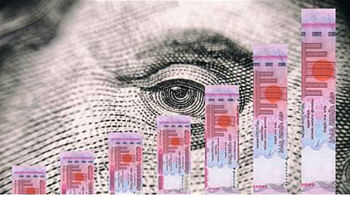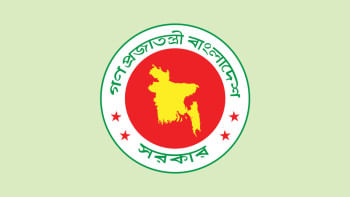Buying vs selling dollars: What should we do?

The US dollar has now surpassed the Tk 100 mark, and Bangladesh Bank is making contradictory moves to deal with the situation. Earlier, it sold USD 7.62 billion from the reserves to protect the value of the taka. More recently, the government has been seeking USD 4.5 billion from the International Monetary Fund (IMF) and USD 1 billion from the World Bank to replenish the foreign currency reserves. Similarly, after failing to shore up the taka even by selling dollars from the reserves, the central bank apparently decided to let the dollar rate be settled by the market. However, according to press reports, it again tried to stop the devaluation of the taka by fixing the rate at which banks can buy or sell dollars.
The sudden appreciation of the dollar can certainly be unnerving. However, much of its cause is rooted in past failures to adjust the exchange value of the taka in a timely manner. For a long time, Bangladesh allowed the taka to be overvalued. The average annual rate of inflation in the US and Bangladesh during the decade of 2012-2021 was 1.88 percent and 6.05 percent, respectively, implying a difference of 4.17 percentage points. Yet the dollar exchange rate increased from Tk 79.1 in 2012 to only Tk 84.8 in 2021, suggesting an average annual increase of less than 0.7 percent. Though the relative movements of the prices of tradable goods and services could provide a more accurate anchor, it is clear that the adjustment of taka's value fell far short of what was required. It may be noted that neighbouring India devalued its currency several times during the last decade. The robust growth of remittances and exports during these years helped Bangladesh to ignore the necessity of this adjustment. However, a combination of a sharp rise in the import bill and a fall in remittances have now brought to the fore the accumulated unwelcome consequences of an overvalued taka.
There is a perception that devaluation of a country's currency reflects deterioration of its economy. This is not necessarily the case. The exchange rate depends mostly on the inflation rates in the economies in question, and a country can do well even if it has a relatively higher inflation rate. Also, the absolute value of the currency does not reflect the strength of a country's economy. For example, as of July 12, 2022, one dollar was equivalent to 137 Japanese yen and 1,934 Italian lira. This does not mean that Japanese and Italian economies are worse than that of Bangladesh. What is important is to ensure that the exchange rate reflects the price levels in the countries in question.
At a general level, the overvalued taka was expected to dampen export and promote import. The intriguing political-economic question is, why there wasn't enough pressure from exporters for correcting the overvaluation. The government's policy of offering cash incentives to exporters could be one answer. RMG exporters still account for about 80 percent of Bangladesh's total exports, and they have been receiving cash incentives ever since their emergence. They also enjoy lower corporate tax rates. Given this generous support, RMG exporters probably did not have much to gripe about the overvalued currency. In the successful East Asian countries, the privileges given to export-oriented industries were always time-bound and generally expired after a decade. By contrast, the privileges enjoyed by the RMG sector in Bangladesh have become a permanent fixture of the landscape.
The other social group that was hurt by the overvalued taka were remittance senders. Unlike RMG exporters, they form a diffuse group, with relatively small per capita gain from the correction of overvaluation, and hence they were unable to mount any collective action. However, they expressed their displeasure by sending more money through informal channels. The government tried to offset this trend, again, with a cash incentive policy, this time directed at the remittance senders.

However, targeted policies of cash incentives are generally inefficient compared to the universal policy of correct currency valuation. Targeted policies often create distortions and lead to unwarranted behaviour. For example, it is widely believed that the cash incentives given for remittances led to recycling of dollars (sent out through hundi, only to be brought back through official channel) to reap the cash incentives. Similarly, the cash incentives on exports seem to have given rise to a perpetual dependence on government largesse, rent-seeking, and the inability to advocate for a more rational exchange rate policy.
The policy of targeted cash incentives is harmful for at least three other reasons. First, it is discriminatory, because not all exporters receive cash incentive schemes, and overvalued currency makes it harder for potential new exporters to sprout. Second, cash incentive schemes create additional burden on the budget. Third, the overvalued currency creates unreasonable pressure for import.
Of course, the forced and somewhat sudden correction of taka's overvaluation, as happening now, is creating the problem of imported inflation. However, artificially trying to protect the high value of the taka is not the solution. The earlier sale of USD 7.62 billion from the reserves was a misguided move and proved to be futile. Similarly, the idea of borrowing from the IMF and World Bank to replenish the reserves is also not warranted. Taking on additional loans is not the solution.
In the short run, the first task is to let a correction of the overvaluation happen. This correction has to be sustained, instead of being a one-shot affair. Second, it is necessary to recognise the potential benefits of the forced devaluation. It can boost exports and remittances and dampen import – which are needed now. Instead of cash incentives that create budgetary burden and can be misused, other creative measures should be devised to encourage remittance flow through official channels. The government has already taken some administrative measures to contain import. These need to be effectively implemented. Third, it is necessary to consider removing or relaxing the cap on the interest rate to curb import demand. Fourth, taxes and duties on imports need to be reviewed to maintain the import of critical inputs. Fifth, subsidies need to be provided to offset imported inflation of particular commodities and for deserving sections of the population.
In the medium term, sectoral management has to be improved. This is particularly the case with the energy sector, which has become a main claimant of foreign currency and subsidies, so much so that it is now threatening our balance of payments and macroeconomic stability. Similarly, with the overvaluation corrected, it should be possible to phase out cash incentives to the RMG sector and lessen the burden on the budget. Thus, with some creativity, the current crisis can also be used to better balance the economy.
Dr S Nazrul Islam is a visiting professor at the Asian Growth Research Institute (AGI) in Japan.

 For all latest news, follow The Daily Star's Google News channel.
For all latest news, follow The Daily Star's Google News channel. 










Comments